Get ready for some action that's so good it's liable to make you gnash your teeth and possibly smash your controller. Devil May Cry 3 is an appropriate about-face for the most memorable of Capcom's more recent franchises, one that started with a bang back in 2001 but flubbed its second outing two years ago. Now Devil May Cry is back, once again featuring the irreverent, inhumanly strong half-demon Dante in the starring role, and it easily presents the series' most challenging adventure yet. Devil May Cry 3 packs in a deep, outstanding combat system, plenty of spectacular story sequences, and lots of flair. Unfortunately, it's unbelievably, unreasonably difficult at first. Think of the most punishing game you played in the last several years. Now, imagine the second or third level of this game being even harder than that. Overcoming Devil May Cry 3's near-vertical learning curve could prove extremely frustrating, to the point where some players will justifiably give up after repeatedly failing the first few missions. That's really too bad, because anyone who perseveres long enough to learn the ropes will probably agree that Devil May Cry 3 is one of the best PlayStation 2 action adventure games since the original.
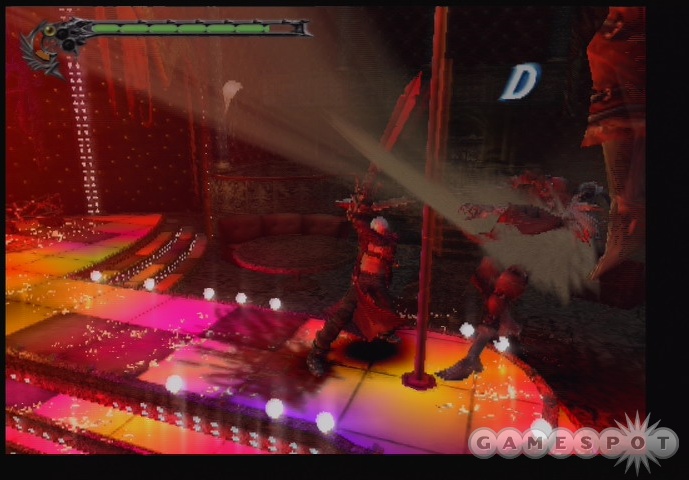
The game's difficulty comes from a variety of factors, one of which is a fundamental disconnect between how Dante is as a character and how you actually need to control him while playing. In story sequences, Dante comes across as a reckless show-off who's practically immortal. In an early cutscene, he willingly lets a group of demonic enemies run him through with their blades, just to spite them. Unfortunately for you, such tactics don't actually work during gameplay, where you'll quickly discover that Dante is actually very easily killed. Another more important lesson takes longer to sink in: Throwing yourself at danger is going to get you killed 100 percent of the time. Again, this is especially true when first starting out, since besides not really knowing how to play the game, you'll start out with a short life meter (a few quick hits will kill you), none of the powerful weapons and abilities you'll acquire later on, and no continues. Devil May Cry 3, which bills itself as a "stylish crazy action" game, projects Dante's own carefree, incorrigible personality, suggesting a level of pick-up-and-play appeal that's actually nonexistent. It's debatable whether or not this is an inherent design flaw, but there's no denying the game drops you off in the deep end right from the start.
Other much more concrete aspects of gameplay also make the early going as tough as it is. For example, there aren't any difficulty settings to choose from at first, and, as a matter of fact, the default difficulty mode here is actually the Japanese version's "hard" mode, which could only be accessed after finishing that version of the game. Whoever at Capcom second-guessed the recently released Japanese game's design and made it even more punishing made a terrible choice that nearly ruins this version. Thankfully, after Dante gets killed a few times, the euphemistically named "easy" difficulty setting is unlocked. Do yourself a favor: Swallow your pride, and start over in easy mode, which you'll find really isn't that much easier but should be surmountable if you've finished other action games that are generally considered to be hard.
It'll initially seem very difficult to avoid getting hit in Devil May Cry 3. You can't withstand many hits, and unlike in similar games, you don't get some sort of invulnerability grace period after you've taken damage. So if five enemies attack you at once, you'll take all five of those hits and will probably die. You're going to die often, whether you like it or not, and at first, you might be inclined to blame this on the third-person perspective and the controls, both of which cease being issues eventually but are likely to give you some serious headaches in the first few hours. You can make Dante automatically attack nearby foes using his guns or his sword, or you can hold down R1 to lock onto a specific enemy. When you're locked onto and facing a foe, you can execute lateral rolls to get out of harm's way...but you must do so by pressing to Dante's left or right on the analog stick rather than to yours, which takes a while to get used to in the context of this game's hectic battles. If you don't perform the move correctly, you'll make Dante jump up instead of roll to the side, and you'll probably get hit. By default, Dante has no other defensive maneuvers to speak of, so any natural inclinations you might have either to retreat from attacks or try to guard against them will be brutally rebuffed.
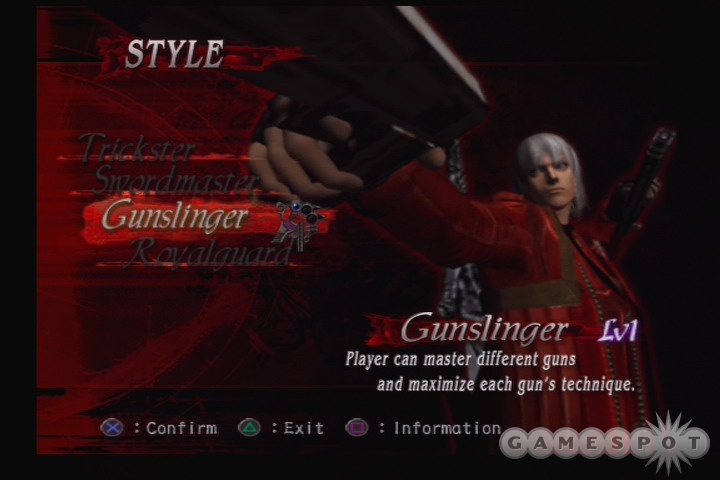
One of Devil May Cry 3's interesting features is that it initially lets you choose from one of four different fighting styles for Dante. These don't completely change the gameplay or anything, but they do encourage a different approach depending on which style you choose. It's possible to switch styles between missions and at certain points during missions, but since you gain experience and eventually new abilities as you keep using a single style, it pays to focus on one at a time. Specifically, it pays to stick with the default "trickster" style on your first play-through, even though it doesn't seem nearly as appealing as the tougher-sounding "swordmaster" and "gunslinger" styles ("royal guard," a defensive style, isn't a good starting choice either).
Again, the difficulty partly comes from simply not understanding the crucial nuances of the gameplay at first, which is something the game's optional tutorial screens do very little to address. You'll be inclined to either charge your enemies using the flashy slashes afforded by the swordmaster style or blast away at them using the gunslinger's fancy shooting. And in either case, you'll get murdered repeatedly. Instead, you should be fighting with utmost caution, keeping your foes at bay, carefully observing their patterns, and avoiding attacks by using the trickster style's incredibly useful starting ability to execute an invincible dash in any direction. Nothing says "trickster" like dodging a giant scythe.
So, the question is, why bother with all this? If Devil May Cry 3 is such a chore to learn, then it had better make the effort worthwhile. The good news is, it does. Eventually, there comes a time when everything just clicks. Suddenly, you get it. You go back and retry those first few levels, even at higher difficulty modes, and you wonder how they ever gave you so much trouble. After all, by then you'll have noticed that all your foes, no matter how big or how powerful, never attack entirely without warning, giving you the split second you need to get out of the way...or strike first. You'll also understand Dante's tremendous potential for causing mass destruction using his ranged and melee weapons in combination. Using his fast, deadly slashes and his unlimited ammo, Dante can make fast work out of throngs of foes, who'll often keep spawning in to attack him from thin air.
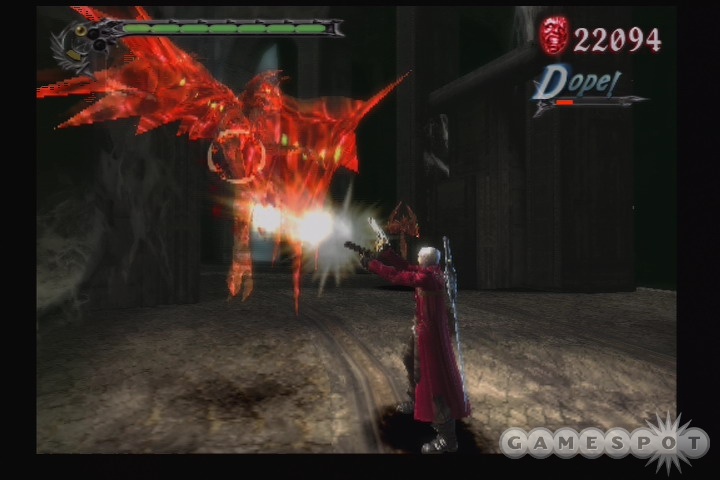
One of the game's excellent touches is that Dante can instantly switch between two different ranged weapons and two different melee weapons at the touch of a button (respectively, L2 and R2). This doesn't seem like such a big deal right off the bat, but you'll soon learn to constantly switch up weapons as you fight, facilitating completely off-the-wall combos that are limited mostly just by your imagination. There aren't a huge number of moves or weapons to choose from in the game, but most of them are useful and interesting, and the variety is very satisfying overall, especially since most of the weapons are uniquely effective both on their own and in combination with any of the others.
Ultimately, what's so great about the combat system is that it's all extremely fluid, responsive, and precise. For example, your initial tendency to hammer on the attack buttons will eventually give way to much more-deliberate actions as you figure out that the game gives you different combo options if you slightly mix up the timing of your button presses. Also, much like you're pretty much always vulnerable to getting mobbed by your enemies, so too are you able to fight dirty. A hard slash (or, say, a shotgun blast) can send a foe sprawling to the turf. Why wait for it to clamber back to its feet when you can just keep whaling away while it's lying there? Or, better yet, why not jump on its back and ride it like a skateboard, spraying bullets every which way before smashing your new ride into that wall over there? And, of course, you've got air-to-air, air-to-ground, and ground-to-air combat to think about. Smash an enemy up in to the sky, and pin it to the ceiling with a hail of gunfire, or jump up after it to continue your assault, and then spray bullets downward to slow your descent.
The game keeps track of just how well you're beating the hell out of hell's forces by means of a combo meter that keeps ratcheting up as long as you keep mixing up your moves and don't get hit. It serves as a helpful reminder that you really ought to experiment rather than keep using the same few slashes over and over. Best of all, though, the variety isn't there just for variety's sake. Many such games let you use an assortment of different moves and combos, but you end up relying on just a fraction of them, simply because they're more effective, and because there's no reason not to keep using them. In Devil May Cry 3, many different moves and tactics are viable against different foes and in different situations, and most of the weapons have different tactical benefits. So in practice, as repetitive as the action may seem, it doesn't get boring. Certainly not on your first time through the game, and after that point, you can go back in to earlier missions with all your new moves and abilities, or you can brave one of the higher difficulty settings. Some unlockable outfits and a few other extras are available, but Devil May Cry 3's real replay value comes from the quality of its fighting system.
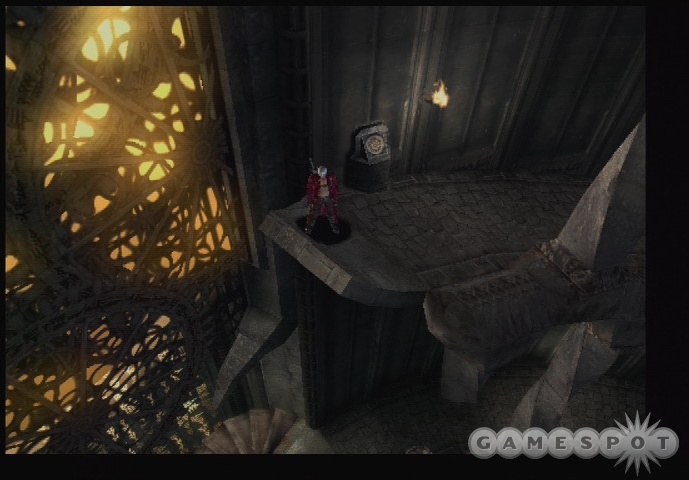
Of course, the game isn't just one nonstop battle after another, though that's kind of what it feels like. It's broken up into a good-sized number of fairly small individual missions, through which Devil May Cry 3 presents a cohesive narrative that pits Dante against his coldhearted twin brother, in addition to legions of infernal cohorts threatening the human world. Most of the game takes place in and around an evil tower that springs up practically in Dante's backyard, so he'll be traveling up and down the thing, chasing down his brother Vergil and Vergil's disturbing friend while occasionally running into a pretty demon hunter who has her own mysterious agenda. The level designs are pretty simple, and even though you don't cover much ground in the game, it still requires you to do a fair bit of backtracking. Some light, almost throwaway puzzle elements occasionally break up the action, and you'll feel encouraged to explore the nooks and crannies of the levels where helpful items are sometimes tucked away. However, you'll spend much more time battling foes than figuring out where to go next.
In turn, you'll spend a chunk of that time squaring off against Devil May Cry 3's numerous powerful boss opponents. These represent some of the toughest, most intense parts of the game, and long after most of the game's regular foes cease seeming to be that great of a threat, you'll still find yourself sweating bullets during these showdowns. For the most part, the boss fights are interesting and very challenging. The opponents themselves aren't always large in stature, but they're almost always fearsome and intimidating in their own rights. You'll have to exploit their few weaknesses while desperately trying to avoid their numerous ferocious, incredibly damaging attacks.
Should you perish, you normally have to start the entire mission over from scratch. Fortunately, as you defeat foes and pass missions throughout the game, you'll earn currency (mostly in the form of glowing red orbs) with which you can buy certain items to make your life easier. One of these items is essential, though the game doesn't bother to stress its importance: the yellow orb that lets you continue a level from a recent point if you die rather than having you start over from the beginning. Other useful orbs can restore your health in a pinch, but they're prohibitively expensive, which keeps you from being able to afford more than a few, unless you plan on spending hours replaying missions over and over until you can buy a bunch.
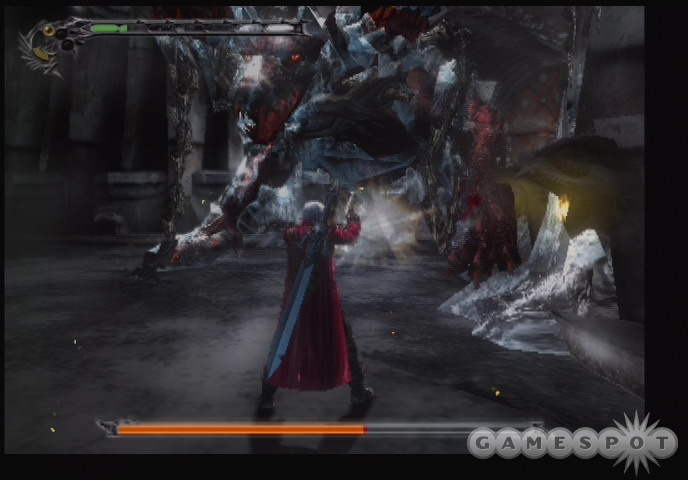
You can also use your currency to power up your guns and learn new moves for your melee weapons, all while leveling up your fighting style and seeking out blue orbs, which increase your maximum health. You'll also eventually learn to temporarily transform yourself into a demon, which makes you faster and stronger and causes your health to regenerate. This is probably the turning point at which the game's difficulty becomes manageable. At any rate, all this helps lend Devil May Cry 3 the essence of role-playing-game-style character development, providing a greater purpose to your every kill and giving you some long-term goals to work toward, above and beyond just finishing the game.
Finishing the game is its own reward. There's not much plot to go on at first, but soon the story picks up and eventually becomes one of the highlights. Specifically, the quality and choreography of the game's between-mission cinematics are stupendous, as these cutscenes are among the most spectacular you've ever seen in a game. Borrowing from the conventions of action-packed anime and the slow-motion martial arts and gunplay from The Matrix, Devil May Cry 3's cutscenes are incredibly over the top and are just as incredibly well produced, thanks largely to some outstanding motion capture work and a cast of great-looking, highly expressive characters.
Devil May Cry 3 features an excellent presentation all around, and it's one of the things that will compel you to keep going even when the going gets really tough. The game moves at a fast, smooth frame rate that almost never falters, and you'll travel through some beautifully designed, gothic environments as you bring the battle to hell's doorstep. Superb animation can be seen throughout, making Dante's moves look both powerful and stylish, though pretty much all the game's various monsters and other characters also look great in motion.
A heavy metal soundtrack--complete with guttural vocals you'll probably memorize and secretly want to sing along with--punctuates much of the game, starting from the very first moments, and it totally fits the theme. You're going to be hearing a lot of the same music since you'll be replaying some sequences over and over again. But in this case, that's a good thing. Devil May Cry 3's sound effects are also very well done, especially the effects for the game's various melee weapons, which make them seem even more menacing than whoever's holding the grip. Solid voice work rounds out a superb audio presentation. Like his personality, Dante's voice is rather abrasive at first, but it fits the character well and will probably grow on you. The other main characters, particularly Dante's brother, also do a good job.
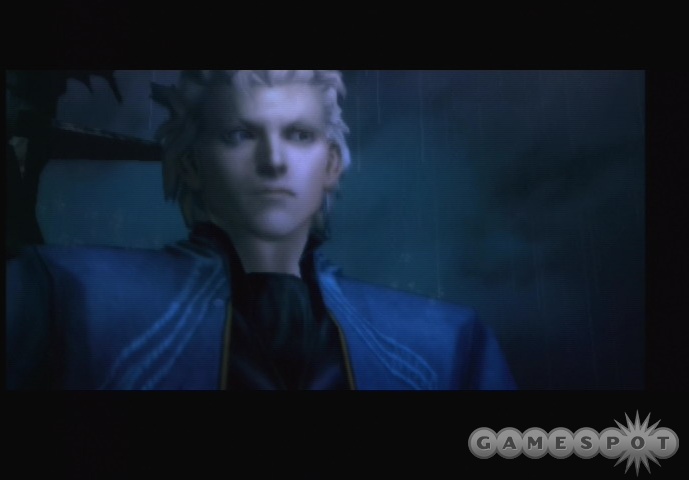
Devil May Cry 3 is a great action game that seems to go out of its way to limit its audience. Let's be clear: There's nothing wrong with a challenging game. On the contrary, many game players these days seem nostalgic for "old-school" games in which having to play through tough levels over and over again was to be expected before yielding the sorts of hard-fought thrills you don't get from breezing through most of today's relatively forgiving games. The thing is, Devil May Cry 3 is much more complicated to play than the old action games from which it seems to draw inspiration, and its difficulty is out of whack, since the game starts off much harder than it ends up, mostly due to certain design decisions that exacerbate the early going. So it comes down to this: Would Devil May Cry 3 have been a better game if its level of challenge were tuned better to make the experience less frustrating to get into? Yes, it would have. With that said, is Devil May Cry 3 an absolutely great action game once you get the hang of it? You bet.